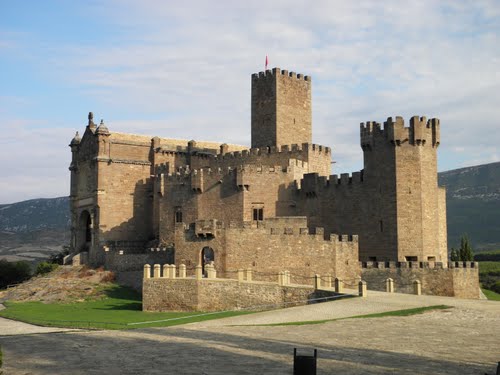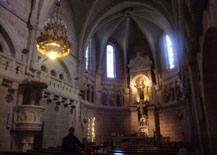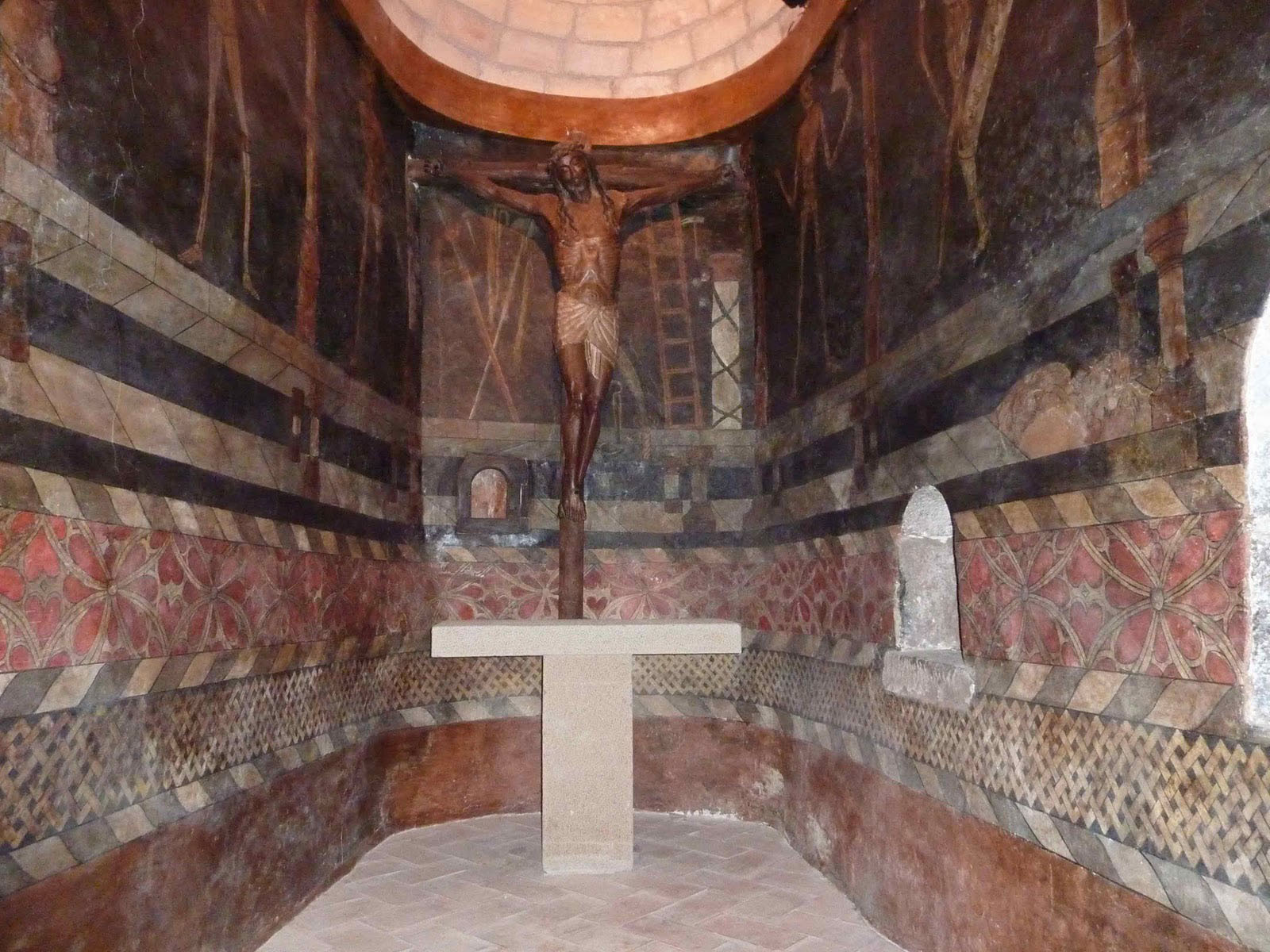
A silhouette of crenellated towers cuts the horizon, welcoming your arrival at the Castle of Javier, the birthplace of San Francisco Javier (St Francis Xavier), patron saint of Navarre, centre of religious missions and tourism in Spain.
The fortress stands on a rock outcrop 8 kilometres from Sangüesa in the Central region of Navarre. Every year in early March the castle is the destination of thousands of people from all over the community in the popular pilgrimage known as the Javierada.
Cross the drawbridge and enter a world of towers, dungeons, machicolations, embrasures and arrow slits, enabling you to get to know the place where Francis Xavier was born (1506) and lived. He was later the co-founder of the Society of Jesus (Jesuits) and one of the most universal missionaries.
Near the border with Zaragoza (Saragossa) province, at the highest part of the small village of Javier, stands  the imposing silhouette of the Castle of Javier, the birthplace of the patron saint of Navarre, San Francisco Javier (St Francis Xavier).
the imposing silhouette of the Castle of Javier, the birthplace of the patron saint of Navarre, San Francisco Javier (St Francis Xavier).
The origins of the castle go back to the end of the 10th century when a signal tower was built called la Torre del Homenaje (Tribute Tower). Its strategic location on the border between the kingdoms of Navarre and Aragon reinforced its role as a fortress, and the different sections of the castle were gradually added on.
In 1516, Cardinal Cisneros ordered an attack on the castle and it was partially destroyed, and at the end of the 19th century, the basilica was built next to the castle. Reconstruction work on the castle began in 1952 gave the fortress its original appearance and nowadays it is one of the few castles that conserve its defences and structures such as machicolations and arrow slits.
 Francisco de Javier was born into a noble family and was the sixth child of Juan de Jasso, an important figure in the kingdom of Navarra, and María de Azpilicueta. He left for Paris at 19 years of age to study in the Sorbonne, where he met Ignatius of Loyola, with whom he was later to found the Society of Jesus (the Jesuits).
Francisco de Javier was born into a noble family and was the sixth child of Juan de Jasso, an important figure in the kingdom of Navarra, and María de Azpilicueta. He left for Paris at 19 years of age to study in the Sorbonne, where he met Ignatius of Loyola, with whom he was later to found the Society of Jesus (the Jesuits).
This is where his evangelising zeal emerged, which led him to travel to thousands of cities, towns and villages in Africa and Asia for 11 years until he died of pneumonia on December 3rd 1552 at the age of 46 when he was about to enter the Chinese Empire. Five centuries later, he has left his mark in all the places he visited, and in his native land, Navarre, he is loved, revered and admired.
On the first two weekends of March, a popular pilgrimage known as the Javierada takes place to the Castle of Javier, in which thousands of people from all over Navarre travel great distances on foot to venerate the Saint.
The origin of this tradition goes back to 1886 when the help of St Francis Xavier was invoked to stop the cholera epidemic that was decimating Navarre; in gratitude for the fulfilment of this desire, the people made a promise to make a pilgrimage to Javier.
cholera epidemic that was decimating Navarre; in gratitude for the fulfilment of this desire, the people made a promise to make a pilgrimage to Javier.
You start in the entrance hall, going through the main door to the castle, where you can see a stone relief with three shields separated by angels, representing the family coat of arms. You go through the stables and down into the basement, where the bodegas (wine cellars) used to be.
A set of dioramas reveals small details of the saint's life, and from here you pass into the main floor with an exhibition of objects from the old castle, souvenirs of the Saint and a model of the old building. This museum is divided into three sections: 1) history of the building, 2) Javier and Navarra in history, and 3) the art gallery, where the highlight is the Flemish canvases by Maes. Finally, a ramp takes us up to the other rooms in the castle.
You start the visit in the Sala de Escudos, decorated with the coats of arms of Francis Xavier's parents and his family tree. Passing through a stone door you gain access to the Sala Principal or Grande (main room), a place for receiving visitors and where the family spent the most time. Then we go up the steps to the Torre de Undués until we reach the Camino de Ronda (battlements), a protected corridor for the defence of the castle. Stones and boiling oil were often poured over attackers through the machicolation!
Leaving the chaplains' rooms (now an oratory) on the left, you enter the old heart of the castle. There are two rooms here around the Tribute Tower, the oldest construction of its type in Navarre. The room on the right was the bedroom of St Francis Xavier, and on the left is the chapel of San Miguel (St Michael), the first one in the castle. Walk out onto the adjacent terrace, where you will get a sense of the strategic location of the castle, and enjoy the spectacular views: to the north, the Sierra de Leyre, to the west, the flood plain of the river Aragon, to the right, the frontier with Aragon, and to the south, the area known as El Castellar.
You then descend to the bottom of the tower, where a corridor takes us to the Hall of the castle and the Capilla del Santo Cristo (chapel of the Holy Christ). Behind a grille stands the Christ of Javier, an impressive 16th-century Gothic image carved in walnut. According to tradition, the figure sweated blood when the Saint was dying in Sanchuan, an island off the coast of China. It is surrounded by a dramatic mediaeval fresco, the only Gothic representation of the Dance of Death that exists in Spain.
Going down the stairs you come to the inner courtyard/parade ground and you exit through the gate. At your feet are the old steps, and on the left (breaking with the construction style of the castle) is the wall of the Basílica, built in the 19th century on the site of the Palacio Nuevo (New Palace) built by the parents of Francis Xavier, where he was born. The tour ends back at the starting point, the entrance hall.
Once the visit to the castle has ended, do not miss the eclectic Basilica, whose façade contains images from the life of Francis Xavier.
A multi-purpose hall called the 'Aula Francisco de Jasso' has been built for the 5th Centenary of the birth of the saint, with capacity for 1,300 people, and also the 'Georg Schurhammer' exhibition hall, with the personal archives of the greatest biographer of Francis Xavier, specially brought from Rome.